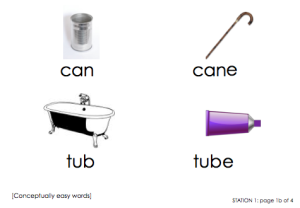Lexercise Courses offer lively, online discussion groups
Written by Sandie Barrie Blackley, Speech-Language Pathologist
Published on August 13, 2013
 Professionals taking Lexercise Courses have access to the course’s online bulletin board, where questions and comments can be shared and discussed with course instructor, Sandie Barrie Blackley and other course takers. Sandie and professionals enrolled in the courses have enjoyed these lively, interactive discussions.
Professionals taking Lexercise Courses have access to the course’s online bulletin board, where questions and comments can be shared and discussed with course instructor, Sandie Barrie Blackley and other course takers. Sandie and professionals enrolled in the courses have enjoyed these lively, interactive discussions.
Questions from our Course Takers
Below is an example of the interactive discussions that are shared on the bulletin for those enrolled in the course:
From Anonymous Course Taker: Why so long for silent -e?
Hi Sandie! I was wondering, what is the reasoning behind waiting so long to introduce silent -e? I think it’s because when introducing all the other graphemes, it would make it easier if you only have to think about short vowels. but it seems like in the books kids read early on in school, there sure are a lot of silent-e words. I get how the process is very systematic and hierarchical, and that introducing silent -e would mess it up, but there sure are a lot of them in the early books. It just seems like such a common pattern, that’s all.
Re: Why so long for silent -e? by Sandie Barrie Blackley
Most Orton-Gillingham scopes (actually all as far as I know) spend a sizable chunk of time initially on building accuracy and automaticity with the short or lax vowels (in closed syllables). That’s because these vowels are hard for people with phonemic processing problems to differentiate and, therefore, they struggle with the rapid, automated association with graphemes. Consider the issue with differentiating the vowels in <pen> and <pin>, for example. Most general education “phonics” programs also start with short vowels, but they move quickly to the other patterns like words with r-controlled and silent –e vowels. That’s because kids with normal language processing don’t need much exposure to assimilate the sound-letter patterns. They seem to do it almost unconsciously. But even very bright adults with dyslexia spectrum processing issues continue to struggle with short vowels. This may be, in part, related to phonological memory issues in dyslexia.
Since the long or tense vowel sounds are the same as the letter names they have the advantage of those memory “hooks.” After the short vowel patterns are nailed down most of the published O-G programs introduce the r-controlled vowels and/or the long vowel patterns (e.g., open syllables, silent –e syllables, or the tense vowel teams). The Wilson Method, for example, introduces the silent –e syllable type (like you suggest) right after short vowels are mastered. But, I know of no research that says it matters in what order the long vowel syllable types are introduced, as long as it’s done explicitly and systematically. The main thing for a dyslexic reader is the material that they are given to read should have no (or very few) words with syllable patterns that they have not been taught explicitly. You do not want a dyslexic to guess from context. You want them to decode the syllable patterns.
So what do you think? Does this sound like something you might be interested in? If you are a practitioner interested in online professional development courses covering language structure and intervention approaches you can learn more here.
Improve Your Child’s Reading
Learn more about Lexercise today.
Schedule a FREE
15-minute consultation


